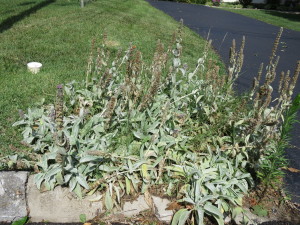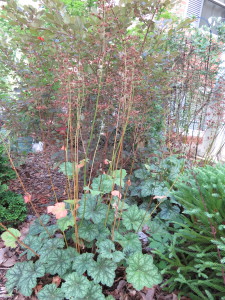“Deadheading”, the practice of removing the old or spent flowers, can be utilized to improve the appearance of many perennials. These perennials do not rebloom after deadheading, but plants look alot better after the cleanup. Daylilies (Hemerocallis cv.), coral bells* (Heuchera spp.), and hostas (Hosta spp.) are prime examples of perennials that benefit from clean up after deadheading.
The flower or plume stalks of many perennials are highly ornamental and can be left to enjoy. Many ornamental grasses are examples here. On others, you risk the dispersal of unwanted seeds which frequently become next year’s weed problem in your garden.
Gardeners opt to remove flower stalks to put all the plant’s energy into the foliage. The following list is not complete, but includes most popular perennials.
Bear’s breeches (Acanthus spinosa)
Bugbane (Actaea podophylla)
Bishop’s weed, goutweed (Aegopodium podagraria)
Japanese anemone (Anemone × hybrida)
Lady’s mantle (Alchemilla mollis)
Goat’s beard (Aruncus dioicus)
Astilbe, False spirea (Astilbe spp.)
False indigo (Baptisia australis)
Bergenia (Bergenia cordifolia)
Queen of the Meadow, Meadowsweet (Filipendula ulmaria)
Cranesbill, Wild geranium (Geranium spp.)
Lenten Rose or Hellebore (Helleborus x orientalis)
Daylilies (Hemerocallis spp.)
Coral bells (Heuchera spp.)*
Rose mallow (Hibiscus moscheutos)
Hostas (Hosta spp.)
Irises (Iris spp.)
Leopard plant, Ligularia (Ligularia spp.)
Catmint (Nepeta × faassenii)
Herbaceous Peony (Paeonia spp.)
Obedient plant (Physostegia virginiana)
Lungwort (Pulmonaria spp.)
Lambs’ ears (Stachys byzantina)
* There are two forms of coral bells, those with showy flowers (average foliage) and those with lush colorful foliage (non-showy flowers).
After deadheading apply a water soluble fertilizer such as Miracle-Gro™ or Schultz™. This is good time to clean up the bed, remove weeds, and add organic mulch. If ground is dry, water deeply the perennial bed by irrigating overhead (equivalent of 1 ½ inches of rainfall) for 3 – 4 hours.



 Posted in
Posted in 
